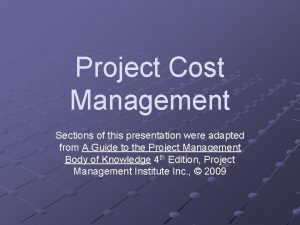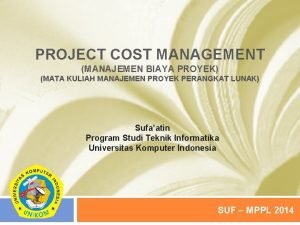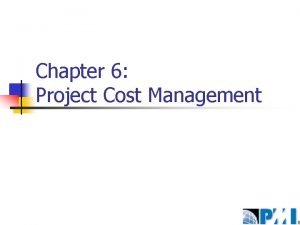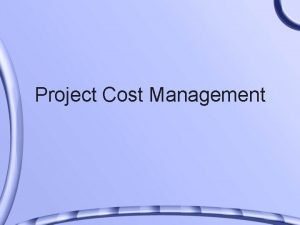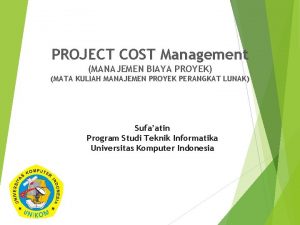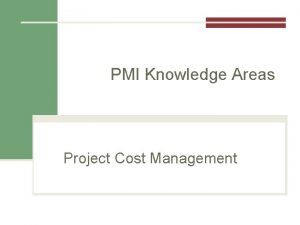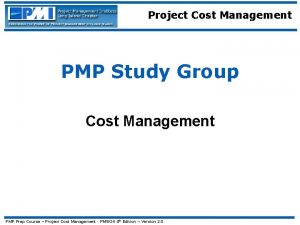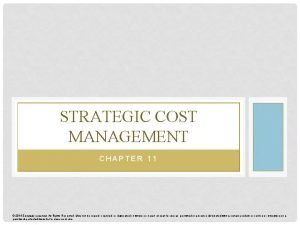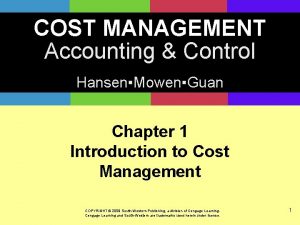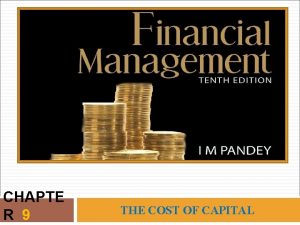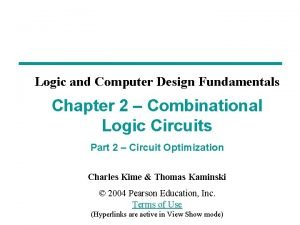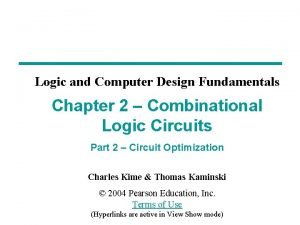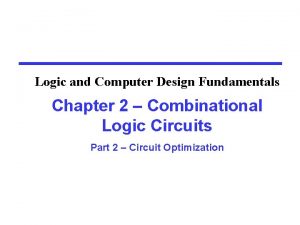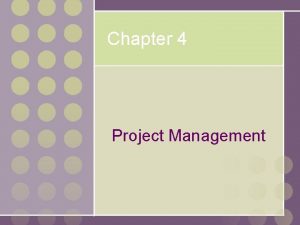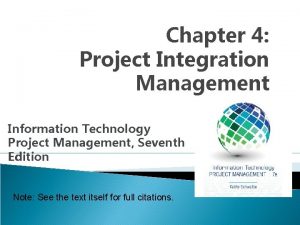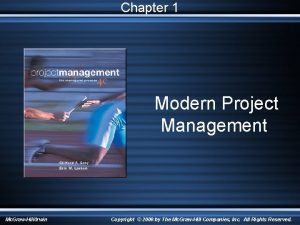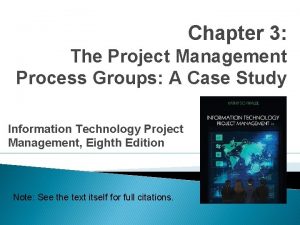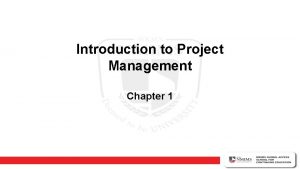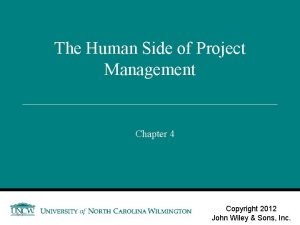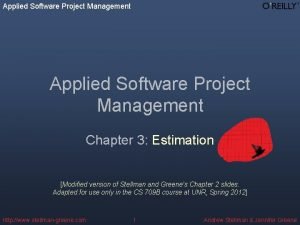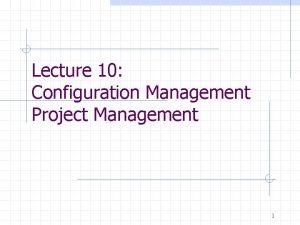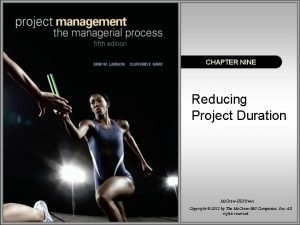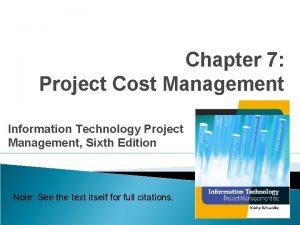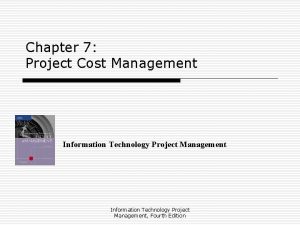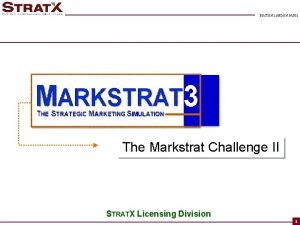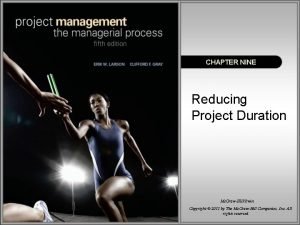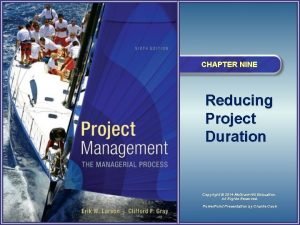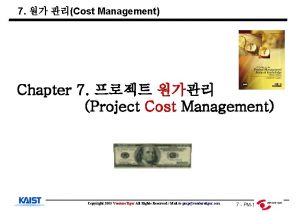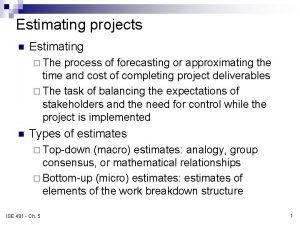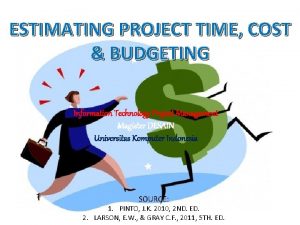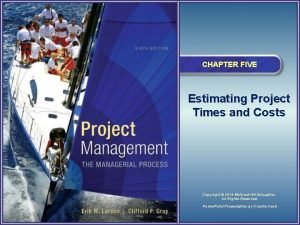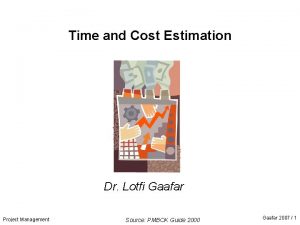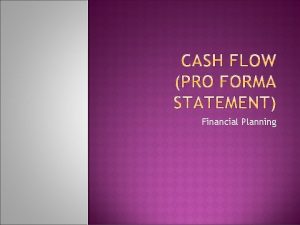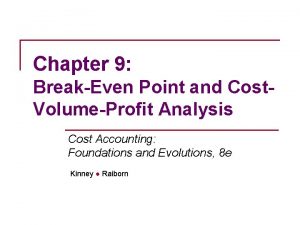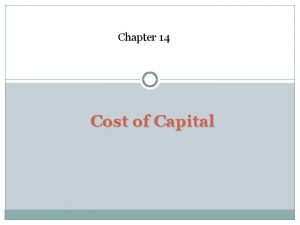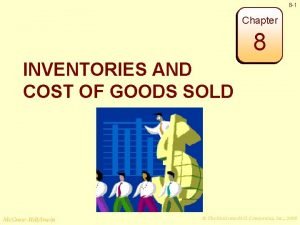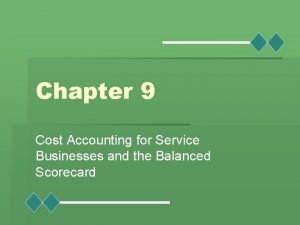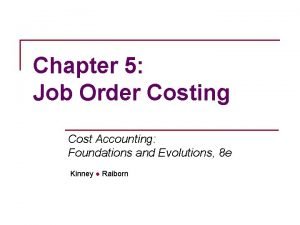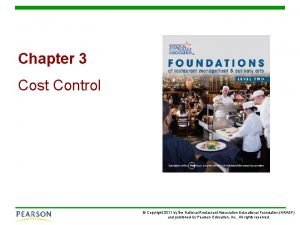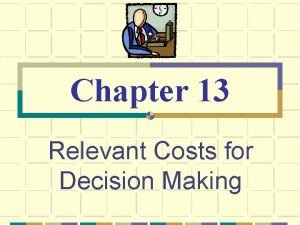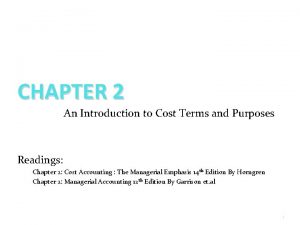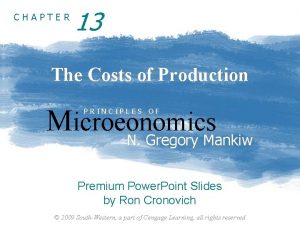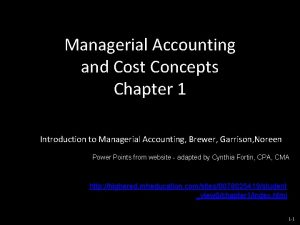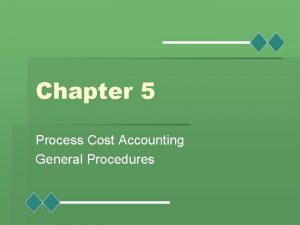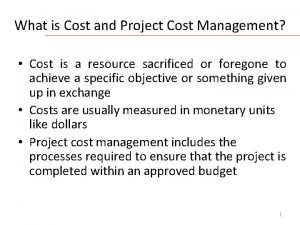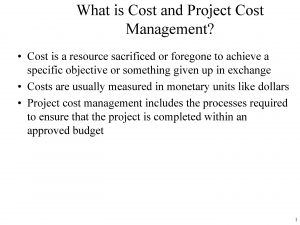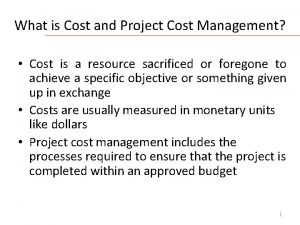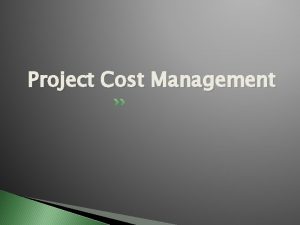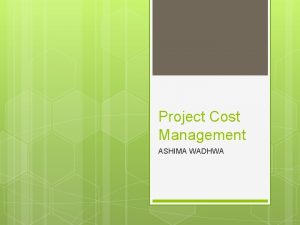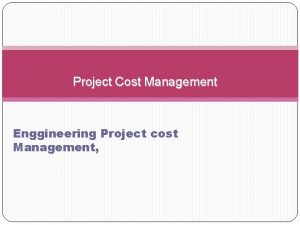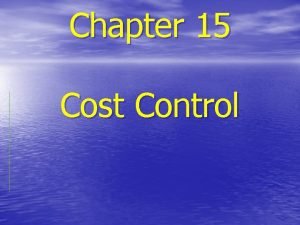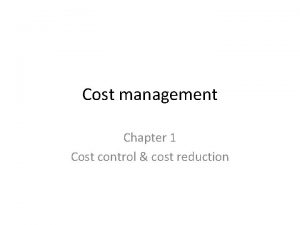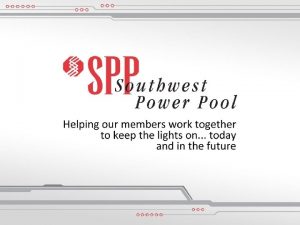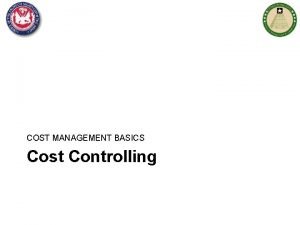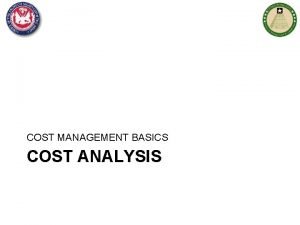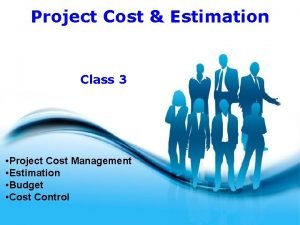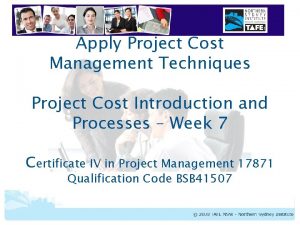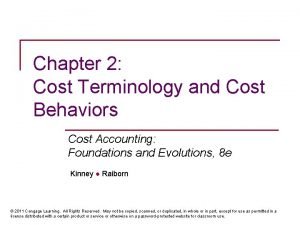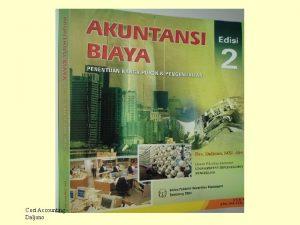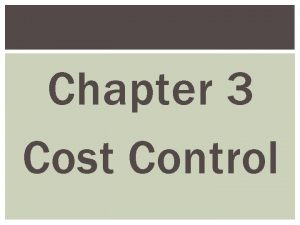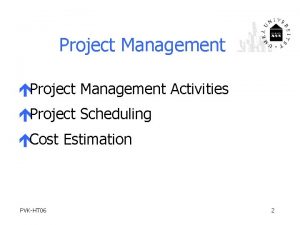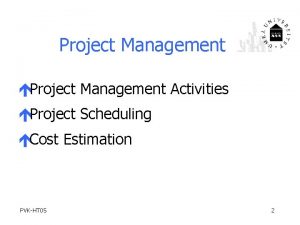Chapter 7 Project Cost Management Project Cost Management
























































































- Slides: 88

Chapter 7 Project Cost Management

Project Cost Management includes the processes involved in planning, estimating, budgeting, financing, funding, managing, and controlling costs so that the project can be completed within the approved budget. The Project Cost Management processes are: 7. 1 Plan Cost Management 7. 2 Estimate Costs 7. 3 Determine Budget 7. 4 Control Costs

Figure 7 -1. Project Cost Management Overview

Key Concepts For Project Cost Management is primarily concerned with the cost of the resources needed to complete project activities. Another aspect of cost management is recognizing that different stakeholders measure project costs in different ways and at different times. In many organizations, predicting and analyzing the prospective financial performance of the projects product is performed outside of the project. In others, such as a capital facilities project, Project Cost Management may address additional processes and numerous general financial management techniques such as return on investment discounted cash flow, and investment payback analysis

Trends and Emerging Practices in Project Cost Management Within the practice of Project Cost Management, trends include the expansion of earned value management (EVM) to include the concept of earned schedule (ES) ES is an extension to theory and practice of EVM

Tailoring Considerations Because each project is unique, the project manager may need to tailor the way Project Cost Management processes are applied. Considerations for tailoring include but are not limited to: • Knowledge management • Estimating and budgeting • Earned • Use value management of agile approach • Governance

Considerations for Agile/Adaptive Environments Projects with high degree of uncertainty or those where the scope is not yet fully defined may not benefit from detailed cost calculations due to frequent changes

7. 1 Plan Cost Management Plan cost management is the process of defining how the project costs will be estimated, budgeted, managed, monitored, and controlled. The key benefit of this process is that it provides guidance and direction on how the project costs will be managed throughout the project.

Figure 7 -2. Plan Cost Management: Inputs, Tools & Techniques, and Outputs Figure 7 -3. Plan Cost Management: Data Flow Diagram

7. 1 Plan Cost Management Continued The cost management planning effort occurs early in project planning and sets the framework for each of the cost management processes so that performance of the processes will be efficient and coordinated.

7. 1. 1 Plan Cost Management: Inputs 7. 1. 1. 1 Project Charter The project charter provides the preapproved financial resources from which the detailed project costs are developed. The project charter also defines the project approval requirements that will influence the management of the project costs

7. 1. 1. 2 Project Management Plan Project management plan components include but are not limited to: • Schedule • Risk management plan

7. 1. 1. 3 Enterprise Environmental factors The enterprise environmental factors that can influence the Plan Cost Management process include but are not limited to: • Organizational culture and structure can influence cost management • Market conditions describe what products, services, and results are available in the regional and global markets • Currency exchange rates for project costs are sourced from more than one country.

7. 1. 1. 3 Enterprise Environmental factors Continued • Published commercial information such as resource cost rate information is often available from commercial databases that track skills and human resource costs, and provide standard costs for material and equipment. Published seller price lists are another source of information • Project management information system provides alternative possibilities for managing cost. • Productivity differences in different parts of the world can have a large influence on the cost of project

7. 1. 1. 4 Organizational Process Assets The organizational process assets that can influence the Plan Cost Management process include but are not limited to: • Financial control procedures • Historical information and lessons learned repository • Financial databases • Existing formal and informal cost estimating and budgeting-related policies, procedures, and guidelines.

7. 1. 2 Plan Cost Management: Tools and Techniques 7. 1. 2. 1 Expert Judgment Expertise should be considered from individuals or groups with specialized knowledge or training in the following topics: • Previous similar projects • Information • Cost in the industry, discipline, and application area estimating and budgeting • Earned value management

7. 1. 2. 2 Data Analysis A data analysis technique that can be used for this process includes but is not limited to alternatives analysis. Alternatives analysis can include reviewing strategic funding options such as: self-funding and equity, or funding with debt, it can also include consideration of ways to acquire project resources such as making, purchasing, renting, or leasing.

7. 1. 2. 3 Meetings Project teams may hold planning meetings to develop the cost management plan.

7. 1. 3 Plan Cost Management: Outputs 7. 1. 3. 1 Cost Management Plan The cost management is a component of the project management plan and describes how the project costs will be planned, structures, and controlled. For example, the cost management plan can establish the following: • Units of measure • Level of precision • Level of accuracy • Organizational procedures links

7. 1. 3 Plan Cost Management: Outputs continued • Control • Rules thresholds of performance measurement Define the points in the WBS at which measurement of control accounts will be performed Establish the EVM techniques Specify tracking methodologies and the EVM computation equations for calculating projected estimate at completion (EAC) forecasts to provide validity check in the bottom-up EAC.

7. 1. 3 Plan Cost Management: Outputs continued • Reporting formats • Additional details Description of strategic funding choices Procedure to account for fluctuations in currency exchange rates Procedure for project cost recording

7. 2 Estimate Costs is the process of developing an approximation of the cost of resources required for the project.

Figure 7 -4. Estimate Costs: Inputs, Tools& Techniques, and Outputs Figure 7 -5. Estimate Costs: Data Flow Diagram

7. 2 Estimate Costs Continued A cost estimate is a quantitative assessment of the likely costs for resource required to complete the activity. It is a prediction that is based in the information known at a given point in time. Cost estimates include the identification and consideration of costing alternatives to initiate and complete the project. Cost trade-offs and risks should be considered, such as make versus lease, and the sharing of resources in order to achieve optimal costs for the project.

7. 2 Estimate Costs Continued • Cost estimates are generally expressed in units of some currency • Costs are estimated for all resources that will be charged to the project. This includes but is not limited to labor, materials, equipment, services, and facilities, as well as special categories such as an inflation allowance, cost of financing, or contingency costs. • Cost estimates may be presented at the activity level or in summary form

7. 2. 1 Estimate Costs: Inputs 7. 2. 1. 1 Project Management Plan Project management plan components include but are not limited to: • Cost management plan • Quality • Scope management plan baseline

7. 2. 1. 1 Project Management Plan Continued The scope baseline includes the project scope statement, WBS, and WBS dictionary: • Project scope statement • Work breakdown structure • WBS dictionary

7. 2. 1. 2 Project Documents Project documents that can be considered as inputs for this process include but are not limited to: • Lessons • Project learned register schedule • Resource • Risk requirements register

7. 2. 1. 3 Enterprise Environmental Factors The enterprise environmental factors that can influence the Estimate Costs process include but are not limited to: • Market conditions • Published commercial information • Exchange rates and inflation

7. 2. 1. 4 Organizational Process Assets The organizational process assets that can influence the Estimate Cost Process include but are not limited to: • Cost estimating policies • Cost estimating templates • Historical information and lessons learned repository

7. 2. 2 Estimate Costs: Tools and Techniques 7. 2. 2. 1 Expert Judgment Expertise should be considered for individuals or groups with specialized knowledge or training in the following topics: • Previous similar projects • Information • Cost in the industry, discipline, and application area estimating methods

7. 2. 2. 2 Analogous Estimating Analogous cost estimating uses values, or attributes, of a previous project that are similar to the current project. Values and attributes of the projects may include but are not limited to: • Scope • Cost • Budget • Duration • and Measures of Scale

7. 2. 2. 3 Parametric Estimating Parametric estimating uses a statistical relationship between relevant historical data and other variables to calculate a cost estimate for project work Parametric cost estimates can be applied to a total project or to segments of a project, in conjunction with other estimating methods.

7. 2. 2. 4 Bottom-Up Estimating Bottom-up estimating is a method of estimating a component of work. The cost of individual work packages or activities is estimated to the greatest level of specified detail. The detailed cost is then summarized or “rolled up” to higher levels for subsequent reporting and tracking purposes.

7. 2. 2. 5 Three-Point Estimating The accuracy of single-point cost estimates may be improved by considering estimation uncertainty and risk and using three estimates to define an approximate range for an activity’s cost: • Most likely (c. M) • Optimistic (c. O) • Pessimistic (c. P)

7. 2. 2. 5 Three-Point Estimating Continued Depending on the assumed distribution of valued within the range if the three estimates, the expected cost, c. E, can be calculated using the formula. Two commonly used formulas are triangular and beta distributions. The formulas are: • Triangular • Beta distribution. c. E = (c. O + c. M = c. P) / 3 distribution. c. E = (c. O + 4 c. M + c. P) / 6 Cost estimates based on three points with an assumed distribution provide an expected cost and clarify the range of uncertainty around the expected cost.

7. 2. 2. 6 Data Analysis Data analysis techniques that can be used in the Estimate Cost process include but are not limited to: • Alternative • Reserve • Cost analysis of quality

7. 2. 2. 7 Project Management Information Systems (PMIS) The project management information system can include spreadsheets, simulation software, and statistical analysis tools to assist with cost estimating.

7. 2. 2. 8 Decision Making The decision-making techniques that can be used in the Estimate Cost process include but are not limited to voting. Voting is an assessment process having multiple alternatives with an expected outcome in the form of future actions.

7. 2. 3 Estimate Costs: Outputs 7. 2. 3. 1 Cost Estimates • Cost estimates include quantitative assessments of the probable cost required to complete project work, as well as contingency amounts to account to identified risks, and management reserve to cover unplanned work. • Cost estimates can be presented in summary form or in detail

7. 2. 3. 2 Basis of Estimates The amount of type of additional details supporting the cost estimate vary by application area. Supporting detail for cost estimates may include: • Documentation of the basis of the estimate (i. e how it was developed) • Documentation of all assumptions made • Documentation of any known constraints • Indication of the range of possible estimates • Indication of the confidence level of the final estimate.

7. 2. 3. 3 Project Document Updates Project documents that may be updated as a result of carrying out this process include but are not limited to: • Assumption • Lessons • Risk log learned register

7. 3 Determine Budget • Determine budget is the process of aggregating the estimated costs of individual activities or work packages establish an authorized cost baseline. • The key benefit of this process is that it determines the cost baseline against which project performance can be monitored and controlled. • A project budget includes all the funds authorized to execute the project. The cost baseline is the approved version of the time-phased project budget that includes contingency reserves, but excludes management reserves.

Figure 7 -6. Determine Budget: Inputs, Tools & Techniques, and Outputs Figure 7 -7. Determine Budget: Data Flow Diagram

7. 3. 1 Determine Budget: Inputs 7. 3. 1. 1 Project Management Plan Project management plan components include but are not limited to: • Cost management plan • Resource • Scope management plan baseline

7. 3. 1. 2 Project Documents Examples of project documents that can be considered as inputs for this process include but are not limited to: • Basis • Cost of estimates • Project • Risk schedule register

7. 3. 1. 3 Business Documents The business documents that can be considered as inputs for this process include but are not limited to: • Business • Benefits case management plan

7. 3. 1. 4 Agreements Applicable agreement information and costs relating to products, services, or results that have been or will be purchased are included when determining the budget.

7. 3. 1. 5 Enterprise Environmental Factors The enterprise environmental factors that can influence the Estimate Costs process include but are not limited to exchange rates.

7. 3. 1. 6 Organizational Process Assets The organizational process assets that can influence the Determine Budget Process include but are not limited to: • Existing formal and informal cost budgeting-related policies, procedures, and guidelines • Historical • Cost information and lessons learned repository budgeting tools • Reporting methods

7. 3. 2 Determine Budget: Tools and Techniques 7. 3. 2. 1 Expert Judgment Expertise should be considered from individuals or groups with specialized knowledge or training on the following topics: • Previous similar projects • Information • Financial • Funding in the industry, discipline, and application area principles requirement and sources.

7. 3. 2. 2 Cost Aggregation Cost estimates are aggregated by work packages in accordance with the WBS

7. 3. 2. 3 Data Analysis A data analysis technique that can be used in the Determine Budget process includes but is not limited to reserve analysis, which can establish management reserves for the project. Management reserves are an amount of the project budget withheld for management control proposes and are reserved for unforeseen work that is within scope of the project

7. 3. 2. 4 Historical Information Reviewing historical information can assist in developing parametric estimates or analogous estimates. Historical information may include project characteristics to develop mathematical models to predict total project costs. Both the cost and accuracy of analogous and parametric models can vary widely. They are most likely to be reliable when: • Historical information used to develop the model is accurate • Parameters • Models used in the model are readily quantifiable are scalable, such that they work for large projects, small projects, and phases of a project

7. 3. 2. 5 Funding Limit Reconciliation The expenditure of funds should be reconciled with any funding limits on the commitment of funds for the project. A variance between the funding limits and the planned expenditures will sometimes necessitate the rescheduling of work to level out the rate of expenditures.

7. 3. 2. 6 Financing entails acquiring funding for projects If a project is funded externally, the funding entity may have certain requirements that are required to be met.

7. 3. 3 Determine Budget: Outputs 7. 3. 3. 1 Cost Baseline The cost baseline is the approved version of the time-phased project budget, excluding any management reserves, which can only be charged through formal change control procedures. The cost baseline is developed as a summation of the approved budgets fir the different schedule activities. Cost estimates fir the various project activities, along with any contingency reserves. For these activities, are aggregated into their associated work package costs. Management reserves are added to the cost baseline to produce the project budget

Figure 7 -9. Cost Baseline, Expenditures, and Funding Requirements

7. 3. 3. 2 Project Funding Requirements Total funding requirements and periodic funding requirements are derived from the cost baseline. The cost baseline will include projected expenditures plus anticipated liabilities.

7. 3. 3. 3 Project Funding Requirements Project documents that may be updated as a result of carrying out this process include but are not limited to: • Cost estimates • Project • Risk schedule register

7. 4 Control Costs is the process of monitoring the status of the project to update the project costs and managing changes to the cost baseline. The key benefit of this process is that the cost baseline is maintained throughout the project.

Figure 7 -10. Control Costs: Inputs, Tools and Techniques, and Outputs Figure 7 -11. Control Costs: Data Flow Diagram

7. 4 Control Costs Continued Updating the budget requires knowledge of the actual costs spent to date. Any increase to the authorized budget can only e approved through the Perform Integrated Change Control process. The key to effective cost control is the management of the approved cost baseline

7. 4 Control Costs Continued The project cost control includes: • Influencing the factors that create changes to the authorized cost baseline • Ensuring that all changes requests are acted on in a timely manner • Managing • Ensuring the actual changes when and as they occur that cost expenditures do not exceed the authorized funding by period, by WBS component, by activity, and in total for the project

7. 4 Control Costs Continued Monitoring cost performance to isolate and understand variances from the approved cost baseline Monitoring work performance against funds expended Preventing unapproved changes from being included in the reported cost or resource usage Informing appropriate stakeholders of all approved changes and associated cost Bringing expected cost overruns within acceptable limits.

7. 4. 1 Control Costs: Inputs 7. 4. 1. 1 Project Management Plan Project management plan components include but are not limited to: • Cost management plan • Cost baseline • Performance measurement baseline

7. 4. 1. 2 Project Documents Examples of project documents that can me considered as inputs for this process include but are not limited to the lessons learned register.

7. 4. 1. 3 Project Funding Requirements The project funding requirements include projected expenditures plus anticipated liabilities.

7. 4. 1. 4 Work Performance Data Work performance data contains data on project status such as which costs have been authorized, incurred, invoiced, and paid.

7. 4. 1. 5 Organizational Process Assets The organizational process assets that can influence the Control Costs process include but are not limited to: • Existing formal and informal cost control-related policies, procedures, and guidelines • Cost control tools • Monitoring and reporting methods to be used

7. 4. 2 Control Costs: Tools and Techniques 7. 4. 2. 1 Expert Judgment Examples of expert judgment during the Control Costs process include but are not limited to: • Variance • Earned analysis value analysis • Forecasting • Financial analysis

7. 4. 2. 2 Data Analysis Data analysis techniques that can be used to control costs include but are not limited to: Earned value analysis (EVA) Planned value (PV) Earned value (EV) Actual cost. Actual Cost (AC)

7. 4. 2. 2 Data Analysis Continued Variance analysis Schedule variance (SV) is a measure of scheduler performance expressed as the difference between the earned value and the planned value. Cost variance (CV) is the amount of budget deficit or surplus at a given point in time, expressed as the difference between earned value and the actual cost. Schedule performance index. The schedule performance index (SPI) is a measure of schedule efficiency expressed as the ratio of earned value to planned value. Cost performance index. The cost performance index (CPI) us a measure of the cost efficiency of budgeted resource, expressed as a ratio of earned value to actual cost.

7. 4. 2. 2 Data Analysis Continued • Trend analysis examines project performance over time to determine if performance is improving or deteriorating Charts. In earned value analysis, three parameters of planned value, earned value, and actual cost can be monitored and reported on both a period-by-period basis and on cumulative basis.

Figure 7 -12. Earned Value, Planned Value, and Actual Cost

7. 4. 2. 2 Data Analysis Continued Forecasting. The project team may develop a forecast for the estimate at completion (EAC) that may differ from the budget at completion (BAC) Forecasting the EAC involves making projections of conditions and events in the project’s future based on current performance information and other knowledge available at the time of the forecast. EACs are typically based on the actual incurred for work completed, plus an estimate to complete (ETC) the remaining work.

7. 4. 2. 2 Data Analysis Continued The project manager’s bottom up EAC method builds upon the actual costs and experience incurred for the work completed, and requires a new estimate to complete the remaining project work. Equation: EAC = AC + Bottom-up ETC When calculating EAC, values, the cumulative CPI and SPI values are typically used

7. 4. 2. 2 Data Analysis Continued Only three of the common methods are described as follows: • EAC forecast for ETC work performed at the budgeted rate • EAC forecast for ETC performed at the present CPI • EAC forecast for ETC work considering both SPI and CPI factors

7. 4. 2. 2 Data Analysis Continued • Reserve analysis. During cost control, reserve analysis is used to monitor the status contingency and management reserves for the project to determine if these reserves are still needed or if additional reserves need to be requested. • If the identified risks do not occur, the unused contingency reserves may be removed from the project budget to free up resources for other projects or operations. Additional risk analysis during the project may reveal a need to request that additional reserves be added to the project budget.

7. 4. 2. 3 To-complete Performance Index The to-complete performance index (TCPI) is a measure of the cost performance that is required to be achieved with the remaining resources in order to meet a specified management goal, expressed as the ratio of the cost to finish the outstanding work to the remaining budget. If it becomes obvious that the BAC is no longer viable, the project manager should consider the forecasted EAC. The equation for the TCPI based on the BAC: (BAC-EV) / (BAC – AC)

7. 4. 2. 3 To-complete Performance Index Continued The TCPI is conceptually displayed in Figure 7 -13. the equation for the TCPI is shown in the lower left as the work remaining (defined as the BAC minus the EV) divided by the funds remaining (which can be either the BAC minus the AC, or the EAC minus the AC)

Table 7 -1. Earned Value Calculations Summary Table Figure 7 -13. To-Complete Performance Index (TCPI)

7. 4. 2. 4 Project Management Information System (PMIS) Project management information systems are often used to monitor the three EVM dimensions (PV, EV, and AC). To display graphical trends, and to forecast a range of possible final project results.

7. 4. 3 Control Costs: Outputs 7. 4. 3. 1 Work Performance Information Work performance information includes information on how the project work is performing compared to the cost baseline. Variances in the work performed and the cost of the work are evaluated at the work package level and control account level.

7. 4. 3. 2 Cost Forecasts Either a calculate EAC value or bottom-up EAC value is documented and communicated to stakeholders.

7. 4. 3. 3 Change Requests Analysis of project performances result in a change request to the cost and schedule baselines or other components of the project management plan.

7. 4. 3. 4 Project Management Plan Updates Any change to the project management plan goes through the organization’s change control process via a change request. Components that may require a change request for the project management plan include but are not limited to: • Cost management plan • Cost baseline • Performance measurement baseline

7. 4. 3. 5 Project Documents Updates Project documents that may be updated as a result of carrying out this process include but are not limited to: • Assumption • Basis • Cost of estimates • Lessons • Risk log learned register
 Principles of cost management
Principles of cost management Cost control and cost reduction project report
Cost control and cost reduction project report Cost control and cost reduction project report
Cost control and cost reduction project report Traditional vs modern project management
Traditional vs modern project management Cost management presentation
Cost management presentation Contoh cost management
Contoh cost management Objectives of cost management
Objectives of cost management Importance of project cost management
Importance of project cost management Contoh project cost management
Contoh project cost management Pmi intranet
Pmi intranet Project cost management lecture notes
Project cost management lecture notes Estimate costs process
Estimate costs process Process of strategic cost management
Process of strategic cost management Cost management accounting and control
Cost management accounting and control Strategic cost management chapter 1
Strategic cost management chapter 1 The role of project management in achieving project success
The role of project management in achieving project success Modern project profiles in software project management
Modern project profiles in software project management Project cost duration graph
Project cost duration graph Introduction to project management kathy schwalbe
Introduction to project management kathy schwalbe Software project evaluation
Software project evaluation Perpetual project closure
Perpetual project closure Ms project agile
Ms project agile Type n terminations
Type n terminations Cost accumulation and cost assignment
Cost accumulation and cost assignment Cost accumulation and cost assignment
Cost accumulation and cost assignment Manufacturing cost vs non manufacturing cost
Manufacturing cost vs non manufacturing cost Job order costing vs process costing
Job order costing vs process costing Flotation cost in cost of equity
Flotation cost in cost of equity Cost concept and classification
Cost concept and classification Cost pools
Cost pools Manufacturing cost vs non manufacturing cost
Manufacturing cost vs non manufacturing cost What is standard costing and variance analysis
What is standard costing and variance analysis Opportunity cost of equity capital
Opportunity cost of equity capital Cost accumulation and cost assignment
Cost accumulation and cost assignment Dennis geyer
Dennis geyer Standard cost is
Standard cost is Literal cost gate input cost
Literal cost gate input cost Distinguish between average cost and marginal cost
Distinguish between average cost and marginal cost Cost control and cost reduction difference
Cost control and cost reduction difference The flow of costs in job order costing
The flow of costs in job order costing Ordering cost and carrying cost
Ordering cost and carrying cost Literal cost gate input cost
Literal cost gate input cost Literal cost gate input cost
Literal cost gate input cost Opportunity costs and trade offs
Opportunity costs and trade offs The relative proportion of variable fixed or mixed
The relative proportion of variable fixed or mixed Chapter 3 project management
Chapter 3 project management Modern project management
Modern project management Information technology project management 9th edition
Information technology project management 9th edition Project management chapter 4
Project management chapter 4 Directing and managing project execution
Directing and managing project execution Modern project management
Modern project management Project management chapter 3
Project management chapter 3 Project management chapter 1
Project management chapter 1 Project management chapter 4
Project management chapter 4 Project management chapter 3
Project management chapter 3 Asset management vs project management
Asset management vs project management Configuration management in project management
Configuration management in project management Define configuration item
Define configuration item Integration management in project management
Integration management in project management Project cost-duration graph
Project cost-duration graph Surveyor pro project cost estimate
Surveyor pro project cost estimate Cost estimation table
Cost estimation table Markstrat r&d strategy
Markstrat r&d strategy Crashing project management example
Crashing project management example Project cost duration graph
Project cost duration graph Project cost duration graph
Project cost duration graph Project cost control
Project cost control Project cost
Project cost Estimating project time and cost
Estimating project time and cost Normal vs expedited costs
Normal vs expedited costs Estimating project time and cost
Estimating project time and cost Lotfi gaafar
Lotfi gaafar Shrimp farm design
Shrimp farm design Cash flow pro
Cash flow pro Hallmarking centre project cost
Hallmarking centre project cost Chapter 12 inventory management
Chapter 12 inventory management Cvp graph
Cvp graph Chapter 3 cost volume profit analysis
Chapter 3 cost volume profit analysis Chapter 14 cost of capital
Chapter 14 cost of capital Chapter 8 inventories and the cost of goods sold
Chapter 8 inventories and the cost of goods sold Cost accounting chapter 9
Cost accounting chapter 9 Site:slidetodoc.com
Site:slidetodoc.com Chapter 3 cost control
Chapter 3 cost control Relevant cost for decision making solution chapter 13
Relevant cost for decision making solution chapter 13 An introduction to cost terms and purposes
An introduction to cost terms and purposes Examples of process cost system
Examples of process cost system Chapter 13 the cost of production
Chapter 13 the cost of production Accounting principles and concepts
Accounting principles and concepts Cost accounting chapter 5
Cost accounting chapter 5




